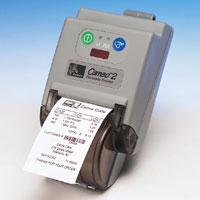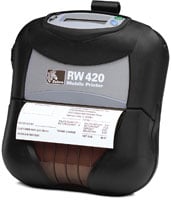Orthopedic Supplies Manufacturer Improves Inventory Control with Bar Codes
 Challenge
Challenge
The company needed to establish a labeling program, and many of DePuy’s distributors and hospitals were implementing automated receiving systems, which required inventory to be bar coded when it reached their receiving docks.
Solution
The system, consisting of 20 on-demand label printers from Zebra Technologies, allowed DePuy to minimize manual data entry, reduce shipping errors, and eliminate the need for costly preprinted forms.
Product
DePuy installed several Zebra® high-performance thermal transfer bar code printers.
On-demand labeling delivers great savings in forms costs by eliminating the need for preprinted forms. Many organizations apply bar coding to improve internal operations, while others adopt the technology to comply with customer or regulatory labeling requirements.
That’s how bar codes came to DePuy Orthepaedics, Inc., an international manufacturer known for its orthopedic products. Implementing bar coding turned out to be a blessing in disguise for DePuy–-they are expecting a $100,000 savings in forms costs alone when all facilities have been converted to the new technology. During the 1980s, DePuy embarked on a plan to widen its distribution channels. Management realized that for the expansion to meet corporate objectives, the company needed to establish a bar code labeling program.
Zebra Mobile Printers Ease Invoicing for Over 2 Million Heating, Water and Electricity Meters
 Unique precision meter-reading system
Unique precision meter-reading system
Brunata A/S uses its own hand-held terminals and the market’s leading portable printers to read two million heating, water and electricity meters a year. Fewer scanning errors, trimmed-down administration and improved customer service are some of the advantages of the new portable scan-print system used by Brunata A/S.
Most work can now be done at the customer’s site
Because the company’s meter readers now use water and heating meters that operate digitally, they are able to complete much of their work at the customer’s premises or home.
The project means that most of all readings are now done by tapping the figures into the handheld terminal. Individual electronic heating meters can be read directly via the terminal. The meter reader can see on the hand-held terminal all the important information for each individual appliance and, in the vast majority of cases, rectify any errors on-site instead of returning to the office and looking up the appliance in the system
Cherry Stream XT Keyboard: Slim, Quiet, Spill Resistant
 New Ultra-Flat Cherry Keyboard is Spill Resistant
New Ultra-Flat Cherry Keyboard is Spill Resistant
Cherry’s new Stream XT ultra-flat keyboard with whisper keystroke technology provides nearly silent operation and high resistance to liquid spills.
With an overall height of just over 0.7 inches, the Stream offers a flat but ergonomic design that complements a contemporary workspace. The Stream has been recognized with the AGR seal of approval for ergonomic, back-friendly work.
The Stream is also built for durability, with standard keystroke life of greater than 10 million operations. Plug & Play means no software installation is needed, and the Stream comes with 6 HotKeys for volume control and Mediaplayer functions.
The Cherry Stream XT is a USB corded keyboard, but it comes equipped with a PS/2 adapter.
Honeywell Scanning and Mobility
 Honeywell Scanning and Mobility (official website) is a Honeywell Automation & Control Solutions business specializing in barcode scanners and mobile computers.
Honeywell Scanning and Mobility (official website) is a Honeywell Automation & Control Solutions business specializing in barcode scanners and mobile computers.
Through the acquisition of Metrologic and Handheld (previously known as Welch Allyn, and HHP), Honeywell has 40 years of barcoding experience.
Honeywell is a leader and 2D imaging, and has a full line of mobile computers for almost any application.
| Entry Level | Light Industrial | Industrial |
|---|---|---|
 ScanPal 2 |
 Dolphin 6100 |
 Dolphin 7850 |
Barcode Scanner Software
See our page on barcode scanner software to help you choose between the many types of available software.
Mac OS X Barcode Scanners

Many of our customers think they need to get a special barcode scanner to use with their Macintosh computer. This may have been true many years ago when USB was not prevalent and Apple computers used ADB connector for their keyboards.
Today, virtually every USB barcode scanner on the market is automatically recognized by Mac OS X thanks to the Apple Generic Keyboard driver that is built into the Operating System. Therefore, all you have to do is plug the barcode scanner in to your USB port and scan your barcodes. They will be entered into any application as if you typed the corresponding keystrokes on a keyboard.
Intermec Rugged Mobile Printers Video
This video demonstrates Intermec rugged mobile printers getting crushed, frozen, baked, dropped, drenched and continue working when it’s all over.
Zebra RW420 Mobile Printers Help Ensure Safe Roadways for the Oregon Department of Transportation
 Challenge
Challenge
The Oregon Department of Transportation‘s Governor’s Office of Highway Safety (ODOT) was established in 1969 to provide a safe, efficient transportation system that supports economic opportunity and livable communities for Oregonians. As part of its mission, ODOT is constantly researching innovative technology and the latest trends in transportation to help the organization continue to keep the roads safe for all citizens.
That’s how ODOT discovered the APS PocketCitation software, an innovative electronic citation system from Advanced Public Safety (APS), designed to automate and streamline the process of issuing traffic tickets.
Based in Deerfield Beach, Fla., APS develops innovative technology solutions specifically designed to address the challenges of today’s public safety agencies. It focuses on creating software that operates in conjunction with the mobile computers and handheld devices utilized by law enforcement, corrections, fire and EMS personnel. APS products work with an agency’s existing technology infrastructure to significantly increase officer safety and productivity.
Previously, traffic citations were manually issued by the officer, who was required to write out a multi-part form. There were four colored copies of each citation, with a copy given to each party involved—the officer, violator, court and department of motor vehicles. Although each entity had the same information, the police department, court and motor vehicle bureau had to re-enter the data into their own computer systems before it went on the driver’s record.
“This process was redundant and time consuming,” said Steve Vitolo, program manager of Statewide Law Enforcement and Judicial Programs, Oregon Governor’s Office of Highway Safety.
Problems also occur when the driver can’t read the officer’s handwriting on the ticket. If the defendant cannot read the court date because the print is faded or not easily read, the defendant will fail to attend on the proper court date. The need to write slowly and press hard also increased the time it took for the officer to write each citation.
In addition, there were issues related to officers recording the wrong court date. Police officers—who work from their vehicles—didn’t always have a calendar at their disposal and sometimes wrote court dates on holidays when the court was closed. This would automatically result in a dismissal due to officer error.
Solution
According to Jeffrey D. Rubenstein, founder and CEO of APS, approximately 20 to 30 percent of all hand-written traffic citations are dismissed because of incorrect statute numbers, illegible handwriting and other administrative data errors. PocketCitation’s on-board intelligence solves these problems by ensuring that the citation information entered is correct and that the citation itself is printed in clear, legible type by Zebra RW 420 mobile printers.
Northeast Medical Center Uses Bar Coding to Increase Patient Safety
 Challenge
Challenge
Since 2000, Northeast Medical Center, a 457-bed acute-care hospital in Concord, North Carolina, has been concerned by the need to improve patient safety, a problem dramatically illustrated in reports issued by the Institute of Medicine, the Joint Commission on Accreditation of Healthcare Organizations (JCAHO), and others, in which medical errors were cited as a central factor in the deaths of between 44,000 to 98,000 U.S. hospital patients annually. Northeast considers itself an early adopter of healthcare technologies, and quickly identified technology as a key element of its renewed commitment to address patient safety.
Larry Hinsdale, Northeast’s CEO, championed an initiative to address patient safety quickly. After considering several alternative solutions, including computerized physician order entry (CPOE) and electronic medical records (EMR), Northeast decided a bar code system would be the most cost effective, manageable patient safety solution, and would yield a collateral benefit to the hospital’s marketing efforts. Northeast began work on a bar code system directed at reducing errors in both phlebotomy specimen collection and in medication administration.
Specimen labels had been printed in batch by printers that were shared and that frequently malfunctioned or produced unreadable bar codes. Batch-printed labels were sometimes applied to the wrong sample. “Each unit had a single printer that was shared between all nurses—a situation that invariably led to errors in labeling,” said Vicki Cooke, Northeast’s expert on nursing information technology systems
Solution
The system went live less than eight months after planning began. The Northeast Medical Center IT department advocated a switch from batch to on-demand printing for specimen collection. Compact Zebra printers are now mounted on a cart along with a laptop. Nurses bring the cart to the patient and produce bar code identification labels when samples are drawn. The labels are applied to the specimen collection tubes, which are color-coded to correspond to the appropriate lab tests. To boost patient safety in medication administration, Northeast now individually packages and bar codes drugs in its pharmacy. Using a laptop mounted on a cart, the nurse scans a bar code on the patient’s identification wristband to pull up the list of drugs to be administered to that patient. The nurse then scans the bar code on the drug to verify that the correct drug is about to be given to the correct patient. The patient’s drug administration record is then electronically updated.
Results
The bar coding system was such an immediate success that all 26 nursing units were equipped with the bar code technology by March 2003.
Methodist Medical Center Uses Bar Coding to Reduce Errors
 Challenge
Challenge
In 1999, Methodist Medical Center in Peoria, Illinois, recorded an incidence rate of five adverse drug events (ADEs) per 10,000 doses of medications administered. At the same time, the Institute of Medicine released its report “To Err is Human,” which highlighted an alarming rate of patient deaths due to preventable medical errors, thus reinforcing the urgency to implement an automated system to reduce the risk of potential ADEs.
Solution
That same year, Methodist’s new chief executive officer, Michael Bryant, formed an executive IT steering committee to find solutions to the patient safety issue. “The bar coding strategy was selected because it provides the opportunity to close the loop of medication ordering and administration, and offers the added benefit of providing a second check for nurses,” said Tom Rippeto, Methodist’s chief information officer. The bar coding system also offered a more accurate, less subjective method of capturing and reporting medication errors.










